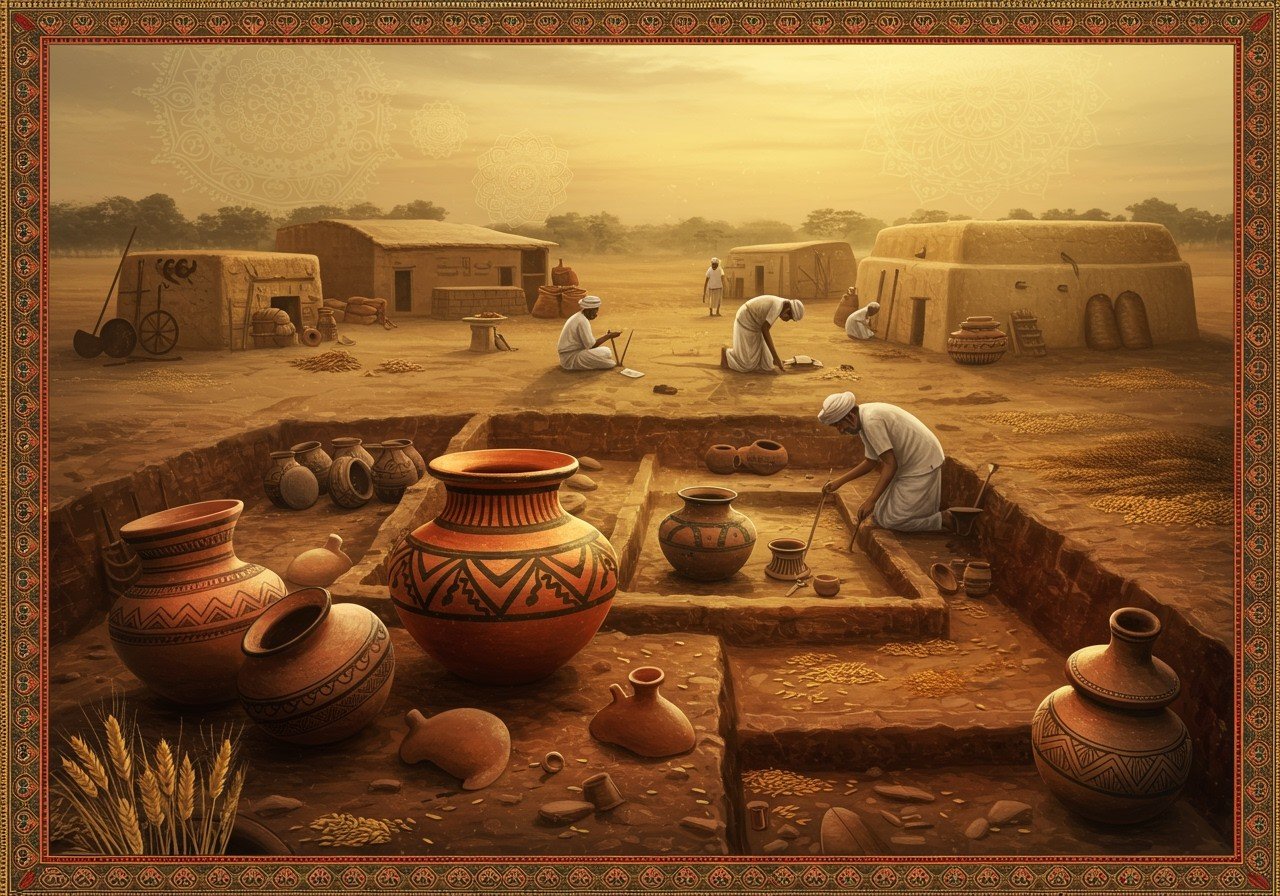
The Jorwe Culture stands as a significant chapter in India’s archaeological narrative, offering a glimpse into the lives of early societies around 1500 BCE. This blog delves into the Jorwe Culture, exploring its origins, development, and contributions to Deccan archaeology, fostering an appreciation for India’s rich heritage among the culturally rooted.
Origins and Flourishing of the Jorwe Culture
The Jorwe Culture prospered in the Deccan Plateau during the middle of the second millennium BCE (around 1500 BCE), primarily in Maharashtra, excluding parts of Konkan and Vidarbha. Named after the discovery site in Ahmednagar district, it’s recognized for its unique painted pottery and blade-flake tools. This culture succeeded the Malwa culture and paved the way for the Iron Age megalithic culture of the Deccan and the Northern Black Polished Ware culture. Excavations across various sites, including Nasik, in western India and the Deccan, have unveiled its widespread presence and significance in the region’s archaeological record.
Key Aspects of the Jorwe Culture
- Distinctive Painted Pottery: The Jorwe Culture is renowned for its unique pottery style, often adorned with intricate painted designs, showcasing the artistic sensibilities of the time.
- Blade-Flake Tools: Advanced toolmaking techniques are evident in the blade-flake tools discovered at Jorwe sites, indicating sophisticated craftsmanship and resourcefulness.
- Settlement Patterns and Architecture: Jorwe settlements, often comprised of clustered huts made of mud and other organic materials, showcase early architectural planning and community organization. These structures, frequently circular or rectangular, reveal insights into their living arrangements and social structures. More information can be found in our blog post about Pataleshwar Caves.
Economic Activities and Subsistence
The Jorwe people relied on a mixed economy encompassing agriculture, animal husbandry, and hunting-gathering practices. They cultivated crops such as barley, wheat, lentils, and millets, possibly employing irrigation techniques. Evidence from animal bones suggests the domestication of cattle, sheep, and goats. Discoveries of beads and metal objects hint at trade and interactions with neighboring cultures. For those interested in learning more about ancient temples and cultural practices, we recommend exploring our blog post on Ancient Shiva Temples of Maharashtra.
Material Culture and Artifacts
Pottery stands as a hallmark of the Jorwe Culture, exhibiting distinct shapes, decorations, and firing techniques. The prevalent red and black ware, often embellished with geometric patterns, reflects both aesthetic preferences and technological skills. Other artifacts include tools fashioned from stone, bone, and copper, alongside ornaments and figurines, offering insights into their craftsmanship and symbolic expressions. If you’re interested in exploring similar artifacts and ritual items, Poojn.in offers a wide selection of traditional and handcrafted products.
Ritual Practices and Social Structures
Burial sites unearthed during excavations suggest a belief in the afterlife within the Jorwe Culture. Grave goods, including pottery, ornaments, tools, and figurines, frequently accompanied the deceased, indicating social stratification and reverence for the dead. These items likely held symbolic meaning and reflected the individual’s social standing. Community spaces may have served as venues for rituals and gatherings, underscoring the social fabric of Jorwe life. To learn more about spiritual meanings and significance in related contexts, you can visit our blog post on Sarasbaug Ganpati.
Jorwe Culture’s Impact on Deccan Archaeology
The study of the Jorwe Culture has significantly enriched our understanding of early Deccan societies. It illustrates the transition from hunter-gatherer lifestyles to agricultural practices. The discovery of planned settlements and granaries points to organized communal living and the emergence of social hierarchies. Ongoing research continues to illuminate the Jorwe Culture’s role in shaping the Deccan region’s history, emphasizing its importance within India’s archaeological heritage. For those interested in exploring the legends, myths, and beliefs associated with regional deities, we recommend our blog post on Saptashrungi Devi.
Poojn.in: Connecting You to Deccan’s Cultural Heritage
Poojn.in, India’s leading cultural goods and services store, offers a diverse range of products that resonate with the rich traditions of the Deccan region. Explore our collection of handcrafted ritual items, puja essentials, and more at www.poojn.in. We offer products such as:
- Radha-Krishna Bigraha: Beautifully crafted sculptures for your home shrine, reflecting the spiritual heritage of the region. These marble dust sculptures are perfect for worship and add a touch of devotion to your home.
- Clay Pots (Hadi Kundo): Traditional clay pots, ideal for cooking and rituals, connecting you to the ancient culinary practices of the Deccan. These handcrafted pots are made with authentic materials and techniques.
FAQs: Delving Deeper into the Jorwe Culture
What defines the Jorwe Culture in the Deccan? The Jorwe Culture, an ancient archaeological culture flourishing around 1500 BCE in the Deccan, is distinguished by its unique pottery, settlement patterns, and burial practices. It provides valuable insights into the early agricultural societies and the development of complex social structures in the region.
Where was the Jorwe Culture geographically located? The Jorwe Culture was primarily concentrated in the Deccan region of India, predominantly in present-day Maharashtra, with some presence in parts of Madhya Pradesh. It thrived in areas beyond the Konkan and Vidarbha regions.
What makes the Jorwe Culture stand out archaeologically? The Jorwe Culture is characterized by distinctive painted pottery, often featuring geometric and linear designs in red and black. Other notable features include large storage jars, terracotta figurines, and specific burial practices involving grave goods, reflecting social hierarchies and beliefs about the afterlife.


